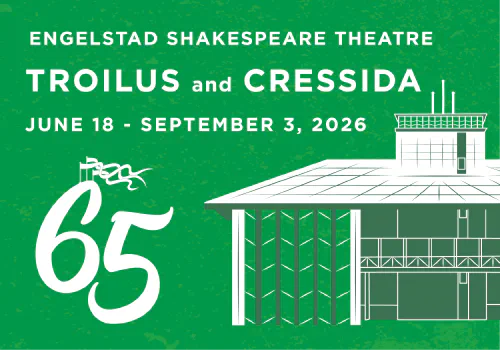By Ace G. Pilkington
In King John, Shakespeare did not follow history as closely as in Richard II and Henry V, but he stayed much nearer the truth than he was later to come in Macbeth. King John resembles the Henry IV plays, where a largely fictional character helps Shakespeare’s story while hurting his accuracy; Falconbridge and Falstaff are equally at fault. In some ways King John looks like Richard III: it is certainly possible to argue that the real John was less villainous than his Shakespearean namesake. Perhaps, though, the most interesting parallel is to Julius Caesar. In both plays there is a real person fictionalized by Shakespeare whose image has also been shaped and changed by other writers. Unlike *Richard III,*whose name inevitably suggests Shakespeare’s play, King John (like Caesar) has a narrative life of his own. Everyone knows the stories of Magna Carta and Robin Hood and instantly associates John with them, but neither the fact of Magna Carta nor the fiction of Robin Hood appears in Shakespeare’s version.
Shakespeare’s distortions are designed to bring his drama closer to the concerns of his audience. The struggle with Arthur and its aftermath, which was, in reality, one of John’s shorter troubles, is stretched until it makes a storyline long enough to hold up the entire play. The issue of an illegitimate ruler wielding legitimate power takes center stage, and so John becomes a usurper while his chief supporter is the bastard son of his older, better brother. Because it makes a neat parallel with the problems of Henry VIII and Elizabeth I, Shakespeare keeps some of John’s struggle with the Catholic Church, which excommunicated him and encouraged a French invasion. However, he recasts John’s fight with his rebellious barons, linking it to Arthur and “outrage at his supposed murder (rather than taxation or other grievances)” (Peter Saccio, Shakespeare’s English Kings: History, Chronicle, and Drama [New York: Oxford University Press, 1977], 202). In fact, Arthur died “around April 1203” (Saccio 193), while the barons’ revolt didn’t occur until twelve years later.
Possibly the quickest way to the truth about King John is to look at the major charges against him. First, he is accused of treason against his father and brother. He was guilty, but he could scarcely have called himself an Angevin prince if he hadn’t been. All of Henry II’s sons and his wife, Elinor of Aquitaine, rebelled against him. Indeed, the counts of Anjou were rumored to be descended from a devil in the female line, and some family members seem to have believed it. During the Christmas celebration of 1182, for example, Henry II stirred up a war with his first and third sons, Henry and Geoffrey, on one side, and his second son, Richard, on the other. Initially, Henry II had been against Richard, but then fought for him. When the Bishop of Winchester chastised Geoffrey for making war on his father and brother, he said, “Do you not know that it is proper to us . . . that brother shall make war on brother, son on father, each against all the others? Do not seek to deprive us of our hereditary right, nor in vain try to change our natures” (cited in Alfred Duggan, Devil’s Brood [New York: Coward-McCann, Inc., 1957], 203).
It was, after all, a time of violence, even among non-Angevins. “The news of Richard’s death reached England on Easter Eve; and its consequences appeared the very next morning, when some of the nobles and knights went straight from their Easter feast to begin a course of rapine and depredation” before a new king could be installed and the laws again enforced (Kate Norgate, England under the Angevin Kings, vol.2 [New York: Haskell House Publishers, Ltd., 1887, reprinted 1969], 390-91).
Next, John is accused of usurping the throne. However, according to the customs in most parts of his far-flung domain, the throne was rightfully his. At that time, England and Normandy would ordinarily have passed the crown to a brother of the previous king rather than a nephew, and, of course, John had (according to most accounts) Richard’s word for the election. By 1197, John seems to have been accepted as heir and, at Richard’s request, was promising in legal documents to honor treaties and exchanges of land “if Richard were to die” (Sidney Painter, The Reign of King John [New York: Arno Press, 1949, reprinted 1979], 6). Two years later, “when Richard realized that he was going to die, he called his men about him, declared John his heir, and ordered them to swear fidelity to him” (Painter 6-7). Queen Elinor saw Richard shortly before his death, and, unlike her Shakespearean counterpart, she never cast doubts on John’s succession.
Also, John is accused of cowardice. This is clearly false. Though he was not, of course, as mad for honor or as successful on the battlefield as Richard, the two were not as different as they are sometimes thought to be. In Alfred Duggan’s words, “Men . . . would follow Richard and John because they were brave soldiers” (225). As Ralph V. Turner says, commenting on modern historians’ evaluations, “They find that John was no coward, and that he showed competence as a military planner, especially at strategy” (King John [London: Longman, 1994], 15).
In fact, the rescue of Elinor, which Shakespeare assigns to Falconbridge, rightfully belongs to John. In May 1202, the fifteen-year-old Arthur was, in true Angevin fashion, besieging his eighty-year-old grandmother in the castle of Mirabel. She, in her turn, led the defense personally, having first sent a message to John to tell him of her plight. Between the morning of July 30 and cockcrow on August 1, John moved his forces ninety miles without stopping for a change of mounts. He finished up with a charge that routed the besiegers and resulted in the capture of Arthur and his sister. Alfred Duggan calls it, “the greatest feat of English arms in France until Crecy surpassed it, and worthy to rank with any exploit of the Lionheart” (299).
Next, John is accused of murdering his nephew or of having him murdered. While there are a variety of possibilities (including Shakespeare’s), it is nearly impossible to construct a plausible scenario that exonerates John. Arthur was taken prisoner, and he vanished. Still, while killing captives (especially family members) is not an admirable character trait, it is hardly unusual among English royalty. Richard II, Henry IV, Edward IV, Richard III, and Elizabeth I (to mention only a few) were all implicated in the elimination of imprisoned relatives. Among Angevins, John was worse than his father, and no better than his brother.
Henry II could justly claim that “during all his long and tyrannous reign not a single captive of importance died in any of his prisons” (Duggan 240). The chivalrous Richard, however, killed “nearly 3,000 Muslim prisoners at Acre in 1191” (Turner 14). To his credit, John kept his other royal relative, Arthur’s sister, Elinor, in easy confinement that included a measure of freedom and what W. L. Warren calls “thoughtful kindnesses” (King John 1167-1216 [New York: Barnes & Noble Books, 1978], 83-84).
Finally, John is accused of tyranny. It is a charge which Peter Saccio conditionally denies, “John was no more wicked or tyrannical than any other strong king of his time” (198). Clearly, John inherited long-standing animosities which his father’s demonic energy and his brother’s military supremacy had suppressed but not extinguished. In Sidney Painter’s words, “There were few who did not nurse some grudge against the house of Plantagenet” (11). At the time of John’s accession, there was already trouble with the barons as a result of Henry II’s “vigorous curtailment of their irresponsible behavior and from the crushing taxes Richard had levied” (John T. Appleby, John King of England [New York: Alfred A. Knopf, 1958], 86).
Winston Churchill perhaps summed up John best: “The difficulties with which he contended, on the whole with remarkable success, deserve cool and attentive study” (The Birth of Britain [New York: Dodd, Mead and Company, 1956], 242). As Shakespeare showed, John’s difficulties were in large part family problems, and he struggled diligently, intelligently, and sometimes cruelly to solve them.










